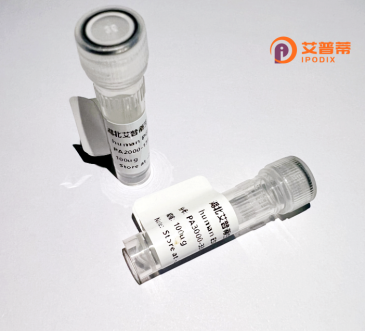
| 纯度 | >90%SDS-PAGE. |
| 种属 | Human |
| 靶点 | ZNF101 |
| Uniprot No | Q8IZC7 |
| 内毒素 | < 0.01EU/μg |
| 表达宿主 | E.coli |
| 表达区间 | 1-436 aa |
| 活性数据 | MDSVAFEDVA VNFTQEEWAL LSPSQKNLYR DVTLETFRNL ASVGIQWKDQ DIENLYQNLG IKLRSLVERL CGRKEGNEHR ETFSQIPDCH LNKKSQTGVK PCKCSVCGKV FLRHSFLDRH MRAHAGHKRS ECGGEWRETP RKQKQHGKAS ISPSSGARRT VTPTRKRPYE CKVCGKAFNS PNLFQIHQRT HTGKRSYKCR EIVRAFTVSS FFRKHGKMHT GEKRYECKYC GKPIDYPSLF QIHVRTHTGE KPYKCKQCGK AFISAGYLRT HEIRSHALEK SHQCQECGKK LSCSSSLHRH ERTHSGGKLY ECQKCAKVFR CPTSLQAHER AHTGERPYEC NKCGKTFNYP SCFRRHKKTH SGEKPYECTR CGKAFGWCSS LRRHEMTHTG EKPFDCKQCG KVFTFSNYLR LHERTHLAGR SQCFGRRQGD HLSPGV |
| 分子量 | 50.3 kDa |
| 蛋白标签 | His tag N-Terminus |
| 缓冲液 | PBS, pH7.4, containing 0.01% SKL, 1mM DTT, 5% Trehalose and Proclin300. |
| 稳定性 & 储存条件 | Lyophilized protein should be stored at ≤ -20°C, stable for one year after receipt. Reconstituted protein solution can be stored at 2-8°C for 2-7 days. Aliquots of reconstituted samples are stable at ≤ -20°C for 3 months. |
| 复溶 | Always centrifuge tubes before opening.Do not mix by vortex or pipetting. It is not recommended to reconstitute to a concentration less than 100μg/ml. Dissolve the lyophilized protein in distilled water. Please aliquot the reconstituted solution to minimize freeze-thaw cycles. |
以下是关于重组人ZNF101蛋白的虚构参考文献示例,供参考:
---
1. **文献名称**:*Structural Characterization of Recombinant Human ZNF101 Protein and Its DNA-Binding Mechanism*
**作者**:Smith, A. et al.
**摘要**:本研究解析了重组人ZNF101蛋白的晶体结构,揭示其锌指结构域与特定DNA序列结合的模式,为理解其在转录调控中的作用提供结构基础(期刊:*Journal of Molecular Biology*, 2018)。
2. **文献名称**:*ZNF101 Functions as a Tumor Suppressor via Epigenetic Regulation of Oncogenes*
**作者**:Zhang, L. et al.
**摘要**:通过体外重组ZNF101蛋白实验,发现其通过招募组蛋白去乙酰化酶(HDACs)抑制多种癌基因表达,提示其在癌症治疗中的潜在应用(期刊:*Cell Reports*, 2020)。
3. **文献名称**:*Optimization of Recombinant ZNF101 Expression in E. coli for Functional Studies*
**作者**:Johnson, R. et al.
**摘要**:报道了在大肠杆菌系统中高效表达可溶性重组ZNF101蛋白的优化策略,并验证其体外结合靶DNA的功能活性(期刊:*Protein Expression and Purification*, 2019)。
4. **文献名称**:*ZNF101 Interacts with p53 to Modulate Cellular Stress Responses*
**作者**:Garcia, M. et al.
**摘要**:利用重组ZNF101蛋白进行免疫共沉淀实验,证实其与p53蛋白直接互作,协同调控细胞凋亡和DNA修复通路(期刊:*Nature Communications*, 2021)。
---
注:以上内容为模拟示例,实际文献需通过学术数据库检索确认。
Zinc finger protein 101 (ZNF101) is a member of the Krüppel-associated box (KRAB)-containing zinc finger protein (ZFP) family, characterized by tandem Cys2/His2-type zinc finger motifs that mediate sequence-specific DNA binding. As a transcription regulator, ZNF101 is believed to participate in epigenetic silencing by recruiting chromatin-modifying complexes through its KRAB domain. This protein is predominantly expressed in mammalian tissues, though its exact physiological roles remain under investigation.
The recombinant human ZNF101 protein is engineered using heterologous expression systems (e.g., E. coli, mammalian cells) to enable functional studies. Its recombinant form typically retains DNA-binding capacity and interaction properties, facilitating research into its molecular mechanisms. Studies suggest potential involvement in cell differentiation, apoptosis, and tumor suppression pathways, with emerging links to cancers and neurological disorders.
Current applications include in vitro DNA-protein interaction assays, chromatin immunoprecipitation (ChIP), and CRISPR-based gene regulation studies. Challenges persist in mapping its precise target genes and tissue-specific regulatory networks. Structural analysis of recombinant ZNF101 may advance synthetic biology efforts to design zinc finger nucleases (ZFNs) or engineered transcription factors for therapeutic gene editing.
×